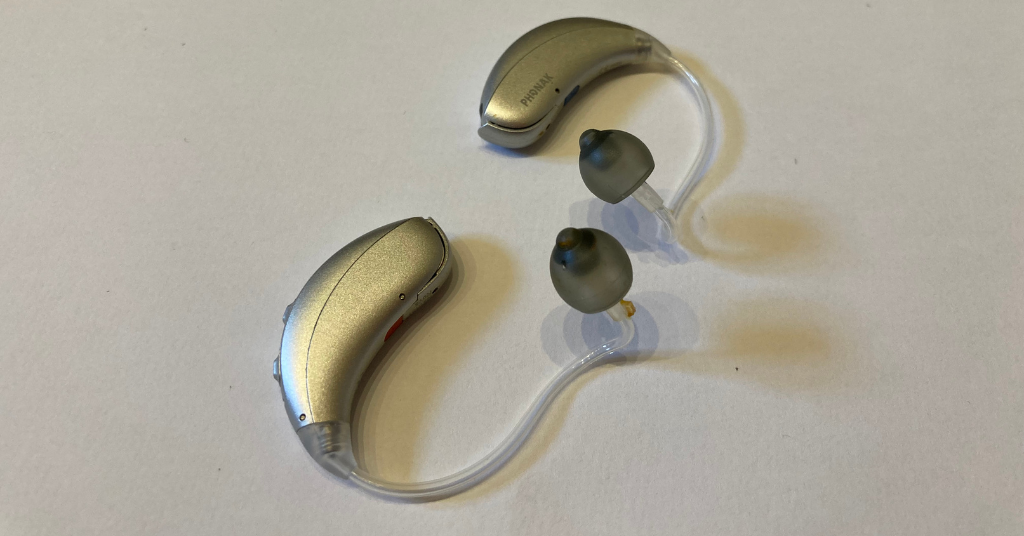“My hearing aids are by far the best thing that has ever happened to me.”
March 22, 2023Forbes names Phonak among best waterproof hearing aids
March 29, 2023Bimodal hearing guidelines published

Individuals who have a unilateral cochlear implant may be candidates for receiving bimodal hearing care. Bimodal hearing simply means utilizing both a unilateral cochlear implant with a hearing aid in the other ear. For many years, it has undetermined if using both devices show any benefit. Most would agree, however, that having another ear effectively utilized is strongly beneficial. A June 2022 article in Otology and Neurotology Open gives recommendations for patients who qualify for bimodal technology.
Key Takeaways of the Bimodal Hearing Guidelines
Approximately 85 percent of cochlear implant recipients are candidates for bimodal technology. With that said, it is important to have the appropriate guidelines to receive the best care.
“Approximately 85 percent of cochlear implant recipients are candidates for bimodal technology.”
Preoperative Cochlear Implant Evaluation
First, the patient needs to be evaluated to see if a cochlear implant is the most effective form of treatment. If the hearing loss goes beyond 70 dB or if the high frequency thresholds are diminished, a cochlear implant in that ear may be effective. Audiograms are effective to help create a baseline. But they are not the only source to see if an individual would benefit from a cochlear implant. Specific questionnaires are useful in addition to the audiograms. These questions target day to day life for the individual. After these are completed, a complete assessment by the ENT surgeon and team should review the patient’s ears and MRI or CT scans of the internal structures of the cochlea, vestibule, and auditory canal.
Postoperative Cochlear Implant Fitting and Assessment
Patience upon activation is needed, as each individual’s success rates vary. Upon activation, the patient may see nearly instant results. Others may need to wait several months until they start noticing key differences. It takes about a year for speech comprehension to reach closer to its full capacity. The article recommends lower stimulation levels according to the specific manufacturer’s directions. To make sure speech is accessible and in its appropriate range, it is recommended that the thresholds be in the 20–30 dB HL range for 250 to 6000 Hz using FM warble tones. For the upper stimulation, is recommended to use eSRTs (Electrical Evoked Stapedial Reflex Thresholds) to implement maximum loudness in a comfortable setting. Each patient should plan to come in for multiple sessions to adjust the cochlear implant settings and make sure it’s working as efficiently as possible.
Bimodal Hearing Aid Fitting
In order to ensure that the ear using the hearing aid is working well, real-ear verification is recommended. There were no specific hearing aid fitting formulas that were found that were shown to help the bimodal approach. But the standard of care is NAL-NL 2 (National Acoustic Laboratories) or DSL-5 (Desired Sensation Level). These are both methods to help provide guidelines for effective hearing aid use. Lowering the frequency of the hearing aid was not shown to provide any positive effects. There is also not enough research yet on the value of synchronizing the hearing aid and cochlear implant, even though it is growing in popularity.
Contralateral Routing of Signal Device (CROS)
It is recommended to prioritize adding a hearing aid or cochlear implant, if possible, before considering a CROS device. It may be helpful for the individual to use a CROS device as it takes in the sound coming from the contralateral side. However, the sound coming from the CROS device may be overpowering as it streams into the unilateral device. Sounds from both sides of the individual are all entering one ear. Utilizing a CROS with a cochlear implant has been shown to help lift the head shadow. It does not help with localization of sound.
Tinnitus Relief
Using a cochlear implant has been shown to help about 70-80 percent of patients with tinnitus. It is still be researched if bimodal use will help tinnitus. There is information showing it may help alleviate tinnitus symptoms.
Aural Rehabilitation
Aural rehabilitation depends greatly on the patient’s goals and effectiveness of their technology. Overall, aural rehabilitation has been proven to be beneficial in individuals with hearing loss. There are a variety of options and alternatives for patients for aural rehabilitation ranging from clinician led or even self-led sessions.
Bimodal Benefits
- In quiet settings, bimodal practices improve hearing about 10-20 percent.
- In environments with noise, bimodal usage increase speech recognition about 10-30 percent.
- Using a both a hearing aid and cochlear implant improves overall ease of listening and better quality of sounds.
If a unilateral cochlear implant user’s other affected ear does not have enough loss to qualify for an additional cochlear implant, using a hearing aid could increase their overall hearing satisfaction. Using both a hearing aid and cochlear implant can improve quality and clarity of sound and speech, may improve sound localization, and may even help decrease tinnitus in some patients.
Related Studies
Background noise is a common struggle for those with hearing loss. This is due to the difficulty in deciphering the main input of sound amidst the layers of extraneous noise. However, other studies have shown the benefits of being able to understand speech even in background noise with a bimodal approach. Most environments include some variety of background noise. Speech recognition evidenced a whopping increase of 10-30 percentage points. This is significant considering the value of understanding language.
Not only does bimodal technology improve speech perception in daily life, but it has been shown to improve the quality of sound including through music. Speech perception success is often what is most important to the patient, but to be able to hear music well is a close second.
Testimonial
I personally have worn a hearing aid for almost my entire life. Later I switched to a bimodal approach. My journey to bimodal technologies however, was flipped. Usually, individuals who opt for the bimodal approach start with a cochlear implant and then add a hearing aid. However, due to insurance regulations and roadblocks, I received my cochlear implant for my profoundly deaf ear about 20 years after wearing a hearing aid.
Receiving a cochlear implant after 20 years of deafness meant that there would be a lower success rate for speech comprehension. However, I chose to move forward with this surgery because of the bimodal benefits. I’ve always said, if I can have more quality hearing, the better.
The implant I chose is not compatible with my hearing aid. However, being a lifelong Phonak user, I wanted to keep using my Naida hearing aid (the Naida Link M does connect to an Advanced Bionics Marvel processor). Regardless of not being able to connect devices, just being able to use my other ear has greatly improved my hearing. My cochlear implant, in addition to my Naida hearing aid, has enabled me to find more enjoyment in music, have the ability to localize where sound is coming from, and significantly improved my speech clarity. I now can’t imagine going back to utilizing just one ear.
Read more: My review of wearing a Phonak Naida Link M with a cochlear implant



